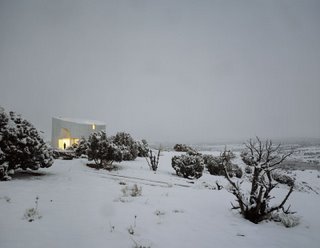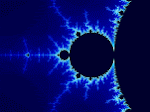
Geoff Huth (whose blog and work I love) mentions the house featured on the cover of last Sunday's NYTimes magazine. I set it aside to read and now really need to get to it. The house was designed by Steven Holl who, among other things, also designed the Cranbrook Institute of Science. (Click on his name to see more beautiful pictures of the house.) I was just wandering around Cranbrook a few days ago, but I somehow missed the science institute; I'm inspired to go back, pronto. Even more interesting is the fact that Turbulence House is owned by the artist Richard Tuttle and the poet Mei Mei Berssenbrugge. I love both of them, but I didn't know they were a couple. Now I realize how "in conversation" their work's are both with each other and with concepts of architecture. Here's a work by Berssenbrugge that must be in direct conversation with the space and physical/intellectual sensations produced in and around Turbulence House:
You could be thinking about your physical placement, what can be a continuum and what is chance. You place yourself innately on a mesa. There are blue hills at each horizon, the light falls copiously onto your open space, the path of the sun and the planets are proportioned around you.
The source of the balance is a sense perception. Your perception of your location is not contingent, but accords with an idea of location inside you, that turns in you like a gyroscope, as you are moving.
I believe in this sense perception of place, because I experience it.
It may be a sense of the shape of a space, or of the balance of features of the space, or it may be a sense of a point on the earth in relation to forces in the earth, which may be affected by stars and planets. Or, it may be in relation to stars and planets.
November 9.
So that the place would sit in me, its wide space with sun, as what it would be in my memory of this time. And how it would be perceived is a matrix of how you were with some people around you, not agents but catalyst or fuel for the perception of light on a wide space, so free as to be impersonal in the company, implacable and impersonal.
November 10.
She would remember that it was a place of the wind. She would think that she would remember the site of sun, and light without sound or without value, but her body is pushed and drawn on by the force of wind on the ridge, every day, so that someday she would remember that she had lived in wind.
The wind can be in the future, a direction, as if there were time, because it comes from somewhere. Because it draws you somewhere, it is the time or space that is the next thing somewhere among the materials of a space or at a time. Because it might be seen as an expression of the forces making it, which push on you or draw from you, it is an expression to everything it is not, and you are reminded you are what it is not, and this expression deters you or abstains from you as a space, when the wind is pushing all night or on a sunny day against the windows and walls of your house.
Then, this expression of being what something is not, joins you with a piece of leaning yellow grass in low sun, or it abstains you from the expression, as if you are more becoming in your mind what you are looking at than what you are feeling.
November 11.
You would be able to see the meaning or whole of the space between the objects on the table, which before had been random space between the fork and the salt crystal.
Now you can see the meaning or the whole of the space between rods of illuminated streaks of clouds at sunset, zooming this way and that, and the volume and vector between them. From you to the horizon gains a meaning. Something happens to you, it is time moving, and you can see them as a whole thing and not the space between one cloud and another that appear on the same plane because of the same color of light on them.
November 12.
We walked in the dry riverbed. Water had left the sand in sweeps of lines and currents, fronds of tamarack drifted in. I want to call it pollen of tamarack drifting into patterns of sand made by currents of water, lift drifts of events in time. But it is more like the bits of tamarack frond, broken by the current and drifting into patterns or record was the time, because of there being something besides a pattern to perceive time by means of.
A skin of tufts of yellow grasses on a hillside threw off the lateral light, and threw down their delicate shadows. The flank of a hill suggesting a living creature.
November 13.
You can see the complexity of autumn plants and trees in the canyon below you. It is late autumn. The yellow and brown jumble of the foliage. Most of the leaves have fallen from the trees and bushes into heaps and drifts on either side of the stream. We are accustomed to think of disorganization and of increasing disorganization as a vector toward entropy. The pleasurable complexity of matter in the canyon would seem to be entropic, except for its beauty. It looks like death. It seems entropic, but it is not entropic, as biological death may not be. And I wonder if the beauty is an innate apprehension of the ongoingness, or "other" than entropy, of that sight?
November 14.
I see the honey moon rise from a bare horizon, after the sunset behind a mountain. I was waiting for the moon. It was a test and not a knowledge of the movement of the risings, by which I am try- ing to judge where I am on this plain. We are trying to understand if the moon sets in a different place than the sun, the sun which is moving and moving down the horizon. Soon, its colored glow will silhouette a mountain called The Wave.



No comments:
Post a Comment